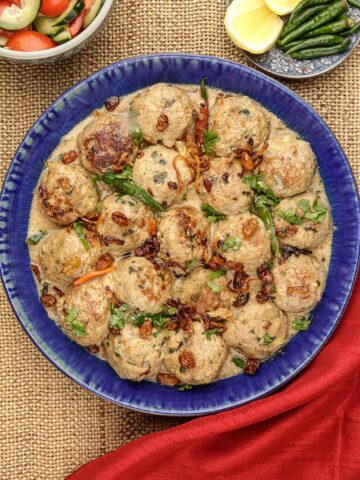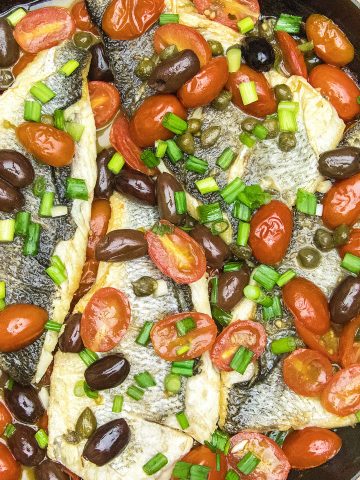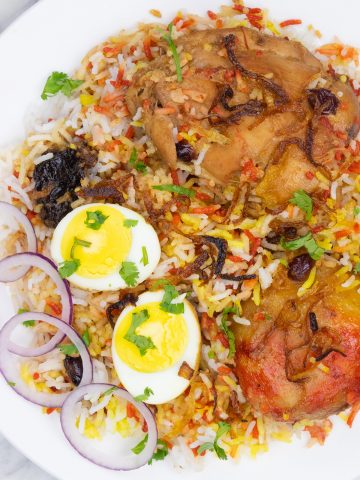Master the art of perfectly steamed basmati rice! Learn expert tips, from rinsing and soaking to mastering the rice-to-water ratio, for restaurant-quality basmati rice every time.

Have you ever experienced the satisfaction of cooking a perfect pot of basmati rice, its fluffy grains delicately perfumed with the promise of a delicious meal? I still remember the first time I attempted to recreate restaurant-style basmati rice, only to end up with a sticky, soggy mess. But over time, I mastered it – and now, I'm thrilled to share my secrets with you. Join me as we unlock the mysteries of perfect basmati rice together.
What is Basmati Rice?
Known for its distinctive fragrance, elongated grains, and fluffy texture when cooked, basmati rice is a long-grain variety of rice primarily grown in the Indian subcontinent. Unlike regular rice, good quality basmati rice has a unique aroma and a subtle flavor which adds a flavorful dimension to Indian food. Basmati comes in multiple varieties and types and is revered as a staple side dish for many Indian dishes especially during festive occasions.
The word "basmati," is derived from the Hindi word for "fragrant." It is renowned for its ability to remain separate and non-sticky after cooking, making it a main ingredient for for various culinary masterpieces in Asia and the Middle East.
Ingredients
The ingredients needed to cook basmati rice are pretty simple and easily available in local grocery stores.

- For this recipe, I used Carolina brand long-grain basmati rice. This method also works with other brands of white basmati rice as well as cooking rice, jasmine rice, and short-grain rice. If using brown rice or brown basmati rice, the cooking process will take longer because of the outer husk.
- You can use either butter or ghee to sauté the rice. You can make ghee at home by simmering butter until all the water is gone and the tiny flecks of protein are toasted to a golden brown. Ghee adds a distinctly nutty, buttery flavor to long grain rice. If you do not have ghee or butter you can use other fats like vegetable oil, avocado oil and olive oil.
- Whole aromatic spices such as green cardamoms, cloves, bay leaf, and cinnamon sticks are used to flavor the slender-grained aromatic rice. You can use other types of spices as well such as star anise, black cardamom, caraway seeds and peppercorns. Use the freshest whole spices so the flavors are as intense as possible.
How to cook perfect basmati rice
Steamed basmati rice uses the 'absorption method' where the rice absorbs all the water during the cooking process. As a result, the proportion of cups of rice to cups of water is crucial. Too much rice will result in an al dente texture. Too much water will result in soggy, mushy rice.

- Rinse and soak. Begin by rinsing 2 cups of raw basmati rice under cold running water until the water runs clear and all the excess starch is removed. For enhanced flavor and texture, especially for aged basmati rice, soak the rice in a large bowl for at least 30 minutes before cooking, or for an optimal outcome, overnight. Once soaked, drain the rice, and allow it to air-dry for about 10 minutes.

- Infuse flavor. In a large stainless-steel saucepan or Dutch oven set over medium-high heat, melt the ghee. Add whole cardamom, cloves, a cinnamon stick, and a bay leaf, then stir gently until fragrant - about 3 minutes. Add the rinsed rice into the pot, ensuring each grain is evenly coated with the fragrant ghee. This last step helps add a subtle nutty flavor.

- Cook and steam. Carefully add 4 cups of boiling water and a teaspoon of salt to the pot. Stir. Increase the heat to high from medium heat, allowing the mixture to come to a vigorous boil. Once boiling, cover the pot with a lid (tight-fitting lid is preferable) and reduce the heat to its lowest setting. Allow the rice to cook covered and undisturbed for 15 minutes. Do not peek! After this initial cooking period, turn off the heat and cook the rice in the residual steam for an additional 15 minutes.

- Fluff and serve. Using a fork, gently fluff the cooked rice to separate the grains. You will notice that some rice grains are plumper than others. To fix this, allow the rice to rest for about 10 minutes. This allows the grains to evenly absorb the water and plump up. Serve hot.
Tips
- Rinse the rice with cold water. Rinsing the rice removes the extra starch which makes the cooked rice sticky, contributing to very fluffy basmati rice. If you do not rinse the rice, you could end up with a sticky film on top of the cooked rice. Use cold water so that the rice does not begin cooking and throw off your cooking time.
- Make sure you soak aged basmati rice. Premium, aged basmati rice is more dry and brittle than the 'fresh crop,' non-aged rice that you typically buy at the grocery store. It is aged for 1-2 years and is much more flavorful and aromatic than non-aged basmati rice. Nanu, my grandmother, a basmati connoisseur, told me that soaking premium aged basmati was critical because the hydration helped ensure that the grains cooked unevenly and did not break during the cooking process. I ruined an entire batch of basmati rice once by skipping this step.
- Use a fork for fluffy rice grains immediately after cooking the rice. Scoop the rice with a fork from the outside of the pot towards the middle. Do not use a spoon or a whisk. Freshly steamed rice is very soft and will easily cut into smaller pieces. If you do not fluff the rice immediately it will clump and be less fluffy. If you do forget, remove the rice from the pot in one big piece and place in a microwave safe bowl. Add 1 teaspoon of water, cover with plastic wrap and microwave for about 3-5 minutes. Then fluff the hot rice.
- Cooking time varies by rice type. A general guideline is 15 minutes to cook and 15 minutes to steam white rice. Brown rice takes longer to cook about 30 minutes to cook and 15 minutes to steam.
- Rice-to-water ratio. I use a 1:2 ratio of rice to water for soft, fluffy, and long, fully expanded grains of basmati rice. Use 1:1.5 ratio of rice to water for al dente rice.
Nutrition
One serving of this basmati rice recipe has about 160 calories, 2.6 grams of protein, 6.3 grams of fat, and 24.5 grams of carbohydrates.
This steamed basmati rice recipe yields approximately 8 servings. The nutritional information is intended as a general guideline. If accurate nutritional information is important to you, you should independently verify it using your preferred tool.
Storage
Refrigerator. Allow the cooked rice to come to room temperature. Stored in an airtight container, the cooled basmati rice will last for up to 4 days in the refrigerator.
Freezer. Frozen basmati rice is perfect for make-ahead and reheats beautifully into deliciously light and fluffy rice. Stored in an airtight container, it will last for about two months in the freezer. Thaw the frozen rice in the refrigerator overnight.
Reheat: Steaming is the best way to re-heat rice and the easiest way to do it is by using a microwave. To reheat, place the steamed basmati rice into a covered microwave-safe bowl and heat for 2 minutes. Continue heating at 30 second intervals until warm. For more detail, please see our post on how to reheat rice.
Serving Suggestions
Due to its remarkable ability to readily absorb flavors, steamed basmati rice is a staple in many parts of the world. Long-grain basmati rice pairs really well not only with traditional dishes like Indian curries but as the main ingredient in other innovative creations. Below are our favorite dishes to serve with steamed basmati rice:
FAQs
There's no one-size-fits-all ratio for cooking basmati rice. Numerous factors influence the required amount of water, including rice moisture content, rice type, pot sealing effectiveness and finally your personal preference for the texture of the rice.
Water ratios range between 1 to 2 cups per cup of rice. As a guideline, I use a 1:2 ratio of rice to water for Carolina brand basmati rice which is readily available at local grocery stores. This results in a soft, fluffy rice with beautifully long, fully expanded grains. For al dente rice use a 1:1.5 ratio of rice to water and a 1:1 rice to water ratio for chewier rice.
When using a rice cooker, pressure cooker or instant pot, follow the manufacturer's instructions. If instructions are unavailable, a general rule of thumb is to use 1.5 cups of water per cup of raw rice. Less water is required for these appliances because of their tight-fitting lids.
The water proportion also needs to be adjusted based on the basmati rice type. Aged basmati requires more water due to its deeper aroma and texture. Conversely, rice stored in a pantry may demand less water if it absorbs water due to a humid climate. Brown basmati rice, with its outer bran layer, typically requires more water and extended cooking times to achieve desired tenderness.
How to cook perfectly steamed basmati rice every time
Ingredients
- 2 cups basmati rice [400] grams
- 4 cups boiling water
- 2 Tablespoons ghee or butter
- 1 cinnamon stick
- 5 cloves
- 3 cardamom smashed
- 1 bay leaf
- 1 teaspoon salt
Instructions
- Rinse and soak. Begin by rinsing 2 cups of raw basmati rice under cold running water until the water runs clear and all the excess starch is removed. For enhanced flavor and texture, especially for aged basmati rice, soak the rice in a large bowl for at least 30 minutes before cooking, or for an optimal outcome, overnight. Once soaked, drain the rice, and allow it to air-dry for about 10 minutes.
- Infuse flavor. In a large stainless-steel saucepan or Dutch oven set over medium-high heat, melt the ghee. Add whole cardamom, cloves, a cinnamon stick, and a bay leaf, then stir gently until fragrant - about 3 minutes. Add the rinsed rice into the pot, ensuring each grain is evenly coated with the fragrant ghee. This last step helps add a subtle nutty flavor.
- Cook and steam. Carefully add 4 cups of boiling water and a teaspoon of salt to the pot. Stir. Increase the heat to high from medium heat, allowing the mixture to come to a vigorous boil. Once boiling, cover the pot with a lid (tight-fitting lid is preferable) and reduce the heat to its lowest setting. Allow the rice to cook covered and undisturbed for 15 minutes. Do not peek! After this initial cooking period, turn off the heat and cook the rice in the residual steam for an additional 15 minutes.
- Fluff and serve. Using a fork, gently fluff the cooked rice to separate the grains. You will notice that some rice grains are plumper than others. To fix this, allow the rice to rest for about 10 minutes. This allows the grains to evenly absorb the water and plump up. Serve hot.
Video
Notes
- Rinse the rice with cold water. Rinsing the rice removes the extra starch which makes the cooked rice sticky, contributing to very fluffy basmati rice. If you do not rinse the rice, you could end up with a sticky film on top of the cooked rice. Use cold water so that the rice does not begin cooking and throw off your cooking time.
- Make sure you soak aged basmati rice. Premium, aged basmati rice is more dry and brittle than the 'fresh crop,' non-aged rice that you typically buy at the grocery store. It is aged for 1-2 years and is much more flavorful and aromatic than non-aged basmati rice. Nanu, my grandmother, a basmati connoisseur, told me that soaking premium aged basmati was critical because the hydration helped ensure that the grains cooked unevenly and did not break during the cooking process. I ruined an entire batch of basmati rice once by skipping this step.
- Use a fork for fluffy rice grains immediately after cooking the rice. Scoop the rice with a fork from the outside of the pot towards the middle. Do not use a spoon or a whisk. Freshly steamed rice is very soft and will easily cut into smaller pieces. If you do not fluff the rice immediately it will clump and be less fluffy. If you do forget, remove the rice from the pot in one big piece and place in a microwave safe bowl. Add 1 teaspoon of water, cover with plastic wrap and microwave for about 3-5 minutes. Then fluff the hot rice.
- Cooking time varies by rice type. A general guideline is 15 minutes to cook and 15 minutes to steam white rice. Brown rice takes longer to cook about 30 minutes to cook and 15 minutes to steam.
- Rice-to-water ratio. I use a 1:2 ratio of rice to water for soft, fluffy, and long, fully expanded grains of basmati rice. Use 1:1.5 ratio of rice to water for al dente rice.
Nutrition
A serving of this basmati rice recipe has about 160 calories, 2.6 grams of protein, 6.3 grams of fat, and 24.5 grams of carbohydrates. This steamed basmati rice recipe yields approximately 8 servings. The nutritional information is intended as a general guideline. If accurate nutritional information is important to you, you should independently verify it using your preferred tool.Storage
Refrigerator. Allow the cooked rice to come to room temperature. Stored in an airtight container, the cooled basmati rice will last for up to 4 days in the refrigerator. Freezer. Frozen basmati rice is perfect for make-ahead and reheats beautifully into deliciously light and fluffy rice. Stored in an airtight container, it will last for about two months in the freezer. Thaw the frozen rice in the refrigerator overnight. Reheat: Steaming is the best way to re-heat rice and the easiest way to do it is by using a microwave. To reheat, place the steamed basmati rice into a covered microwave-safe bowl and heat for 2 minutes. Continue heating at 30 second intervals until warm. For more details, please see our post on How To Reheat Rice.
DID YOU MAKE THIS RECIPE?
We'd love to hear how it turned out. Please take a picture and tag us on Instagram @cloveandcumin!





















Charah
I just learned about soaking the rice first, thanks for sharing!!
Lima
Glad it was helpful!
Casey
I really enjoy Basmati rice and these are great tips. Thanks for sharing!
Lima
Awesome!
Nathan
This is such a great guide for cooking rice! I often forget to soak and rinse it first, but I'll remember from now on thanks to this post!
Lima
awesome - thanks Nathan!
Chenee
I did not realize you're supposed to soak the rice first - that would explain why it never came out right for me! Thanks for sharing!
Lima
Glad it was helpful!